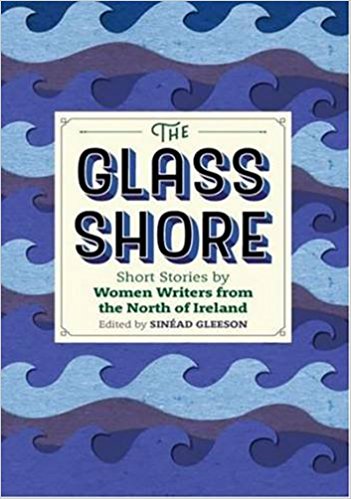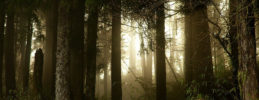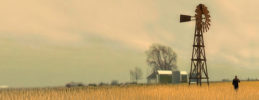
('Aurora' © John Purvis,2015)
MIND YOUR LANGUAGE: HOPE AND HEARTBREAK FROM FEMALE IRISH WRITERS
By ZOE MITCHELL
The Glass Shore: Short Stories by Women Writers from the North of Ireland is a collection of twenty-five short stories from female writers offering a glimpse into the history and cultural heritage of the region. It is also testament to a strong tradition of storytelling and literary strength amongst female writers. Here, they take the reader from the city to the country, from land to shore and through the passage of time. The collection is ordered chronologically and includes six stories written in the 19th Century, with the rest spanning the years up to the present day. This arrangement highlights changes in styles and attitudes and shows how stories and culture can remain largely unchanged across the years.
There is a curious symmetry to the first and last stories, both concerned with magic and romance, but these belie the immense grit and insight displayed by all the writers in this collection. The stories include moments of drama and tension, wry social commentary and everything from satire to the supernatural. Whilst the editor, Sinéad Gleeson, says in the introduction that there is no theme to the book, there is clarity of vision carried throughout, even as the stories chart the changing fashions in writing style and preoccupation. Reading this collection brought to mind the famous Maggie Kuhn quote, “speak your mind – even if your voice shakes.” This collection brings together writers courageous enough to speak their minds, overturning intimate details and grand landscapes. Presented in this collection together, those voices never waver.
The opening story is by Rosa Mulholland – a writer I am ashamed to admit I was unaware of prior to reading this collection. This is despite her having an immense back catalogue and endorsement of none other than Charles Dickens himself. The story has it all – heroes and villains, intrigue, romance and a touch of the supernatural, all set against a stunning backdrop. Nothing better demonstrates how much women’s writing has been systematically ignored by the establishment. It would make an excellent companion to anything by Dickens or indeed as a subject in its own right. The vivid and evocative details given to the landscape and the strange house where a mysterious father and daughter live, give a strong sense of place and atmosphere, and serve to build the tension within the story:
It was a curious, old, grey, weather-beaten building, wedged into and sheltered by the cliffs, and looking as if in some early age it might have been carved out of their grim masses. The observatory was a much newer erection – a round tower with a glass chamber at its top, resembling a lighthouse to warn mariners from these dangerous rocks.
 Women may have been kept in their place within the literary establishment – and indeed within Ireland – but that hasn’t rendered them powerless. There are flashes of female strength throughout the collection. Alice Mulligan’s story ‘The Harp That Once –!’ has a heroine using her feminine wiles and the power of music to protect someone who is under threat of capture from visiting soldiers. The story demonstrates both the powerlessness of women against the might of military weapons and the opportunity that their assumed weakness presents as this extract shows:
Women may have been kept in their place within the literary establishment – and indeed within Ireland – but that hasn’t rendered them powerless. There are flashes of female strength throughout the collection. Alice Mulligan’s story ‘The Harp That Once –!’ has a heroine using her feminine wiles and the power of music to protect someone who is under threat of capture from visiting soldiers. The story demonstrates both the powerlessness of women against the might of military weapons and the opportunity that their assumed weakness presents as this extract shows:
It was with a feeling of ill-conceived antipathy that she first greeted the captain. He was quite a distinguished person – he had done good service against the rebels. Mabel knew what that meant; knew, too, what errand he was bound on that very night, and made up her mind to foil him by woman’s wit.
Ere they passed from the drawing-room to the dinner, she smiled very archly and asked if he cared for music.
Margaret Barrington’s compelling and tense story ‘Village Without Men…’ shows the complexity of a female-only society. In some ways, the women are shown to be self-reliant, stronger and more peaceful without men.
As they cut the sea wrack for their fields, they called to one another and sang snatches of old songs. Sometimes one or another would stop in her work and look out over the water at the sea-swallows dipping and skimming over the surface of the water, at the black shags as they swam and dived, at old Leathering standing in his corner to wait.
However, as a young boy comes of age, his presence invokes rivalry and he is driven away. As young girls become women, they move away to find marriage, leaving behind a population growing older and with less hope than they had before. It has vividly drawn characters and vignettes that present the contradictions within the idea. The story doesn’t present any simple solutions, this is no utopia that is being presented, but in situating the story in a village without men, Barrington can explore female characters defined outside the standard parameters of wife, daughter or object of affection.
Clarity of setting is an aspect that all these stories share – from the dramatic landscape of the country and the coast to the sometimes claustrophobic hotels, hospitals and a convent. In Janet McNeil’s story ‘The Girls’, you can all but feel the chill damp rain falling on you as you read. The story itself is concerned with social dynamics and there are subtle and sinister undercurrents to the tale. The story is based around a school reunion, and plays on the tension and expectation of the situation and the re-emergence of past emotions and alliances. The setting is clearly rendered but the action is less certain, with nostalgia turning to disappointment and reality making an unwelcome entrance for the protagonist.
At the reunion, Alice has something to prove, but the girls, her former classmates, close ranks. After embellishing the details of her life in London, Alice finds that,
…her neighbours returned to their discussion of Streaming in Schools, Teenage Sex and What Was the Church Doing Anyway? Her lower lip had thickened, her face forbade him to look at her and offer any kind of comfort.
We may see the scenes clearly, but the story calls our memories into question and makes us ask why we keep them so close and nurture the past, often to the detriment of the present.
‘Capering Penguins’ by Sheila Llewellyn takes this idea further; the value of literature itself is brought into question by the realities of life in Northern Ireland after the First World War. The unnamed protagonist laments how accurately Sassoon had captured the experience of the trenches and yet how little he wants to read his work or any other. Books and stories have begun to present a threat, further tumult and confusion after the trauma of war and the eerie tone of the story slowly gathers momentum towards an inevitable conclusion. The books appear to represent the overwhelming nature of the returning from the front, and both the everyday world and the world of fiction appear impossible to navigate;
I stare past his head at the two shelves of paperbacks, blue and orange and green and pink, the little penguin logo standing plump and firm on the spines of books published in the ‘30s, a much skinnier version dancing a jig by 1945.
The penguins begin to caper round in my head.
As a portrait of post-traumatic stress disorder it is both unsparing and empathic; as an examination of the failure to find words it is both moving and thought provoking.
The possibilities and failures of art are also the concern of Rosemary Jenkinson’s story ‘The Mural Painter’. The painter is seen as less than worldly, but political and religious concerns intrude on his work. The story presents a microcosm of the violence of division through ideology but while the value of art may be in question people are seen to present the real hope. The artist develops his work following the apparition of a woman, and it is his pragmatic mother who protects and cares for him throughout. These twin strands of romantic ideals and reality can be seen throughout the book and suggest that perhaps we need both artistic elevation and a dash of more down-to-earth action in our lives.
Inevitably, given the location of the writers in a landscape marred by war, division and political upheaval, politics features throughout the collection. Evelyn Conlon’s story ‘Disturbing Words’ is small in its setting and domestic in its concerns, but shows clearly the violence of borders and division and the physical, psychological and emotional barriers they may construct and how they echo within a place long after the conflict has been resolved.
“My father had been hurt young by the border; the line ran on the top of their ditch. His mother had mourned the loss of her friends, from both sides of the house.”
“That’s making them from a different country. How could that be?”
She stopped to think about it some more.
“So if you were born in the six counties before now, where will they say you were from? You can’t have been from somewhere that never was.”
The story centres around a rootless young woman returning from Abu Dhabi, where she lives and works as an ex-pat, to bury both of her parents after they die within a week of each other. The recalled advice of the grandmother in the story, ‘always live away from the border’, is writ large in the narrative of this story and many others within the collection.
Bernie McGill’s ‘The Cure For Too Much Feeling’ has similar concerns and shrinks even smaller to the viewpoint of one woman. The protagonist Rita is a lifelong spinster who works most of her life in a factory and suffers, late in life, from an awareness of her own isolation. The walls she has constructed to keep herself safe crumble, and the recognition of her own loneliness is heart breaking. This is a spare story in which no word is wasted; when talking about giving up a child she talks of how she had ‘given her up almost immediately,’ and there is a world of loss and longing in that one word, almost.
Religion is another inevitable feature of the stories within the collection. The intractable religious dogma, and in particular its impact on women, is most sharply drawn in Frances Molloy’s story ‘The Devil’s Gift’. The story highlights a trap within religion that perpetuates suffering. As a nun explains to the novitiate,
We must all carry the cross he has laid down for us. If your cross is a heavy one, Sister, that is merely a reflection of how deeply he loves you.
The story also exposes the hypocrisy of the church and provides a claustrophobic and chilling picture of life within the convent. From the money offered to accept the novitiate to the arbitrary rules and harsh conditions, the nuns running the convent show nothing close to Christian charity. Instead of peace, the convent appears to be run through fear – fear of punishment, isolation and further privations. When the protagonist walks out ‘into the light’ the reader is similarly released from the thick walls of the institution and is made to see that what lies behind religious institutions is not God, but people.
The beauty and magic of the final story, ‘The Seventh Man’ by Roisin O’Donnell, sums up much of what is so enchanting about the collection. The story offers a strong sense of place, social commentary, vividly drawn characters, romance and magic. The story follows the decline of an apparently immortal woman who uses men to retain her seemingly never-ending youth and vitality. The story is also a great example of the wit shown throughout the collection, with a centuries old witch left scouring Tinder for victims when the shipping route near her lair ceases to run.
As a collection, all the stories display a tension and contradiction at their heart, that comes from the vivid portraits they present. The witch in the final story warns that ‘the most dangerous thing you can do on this earth is fall in love,’ and yet admits that love, rather than her own enchantments, made her feel young. Like the women in the ‘Village Without Men’, freed from male rule and longing for its return, these contradictions are what tug at the heart and the imagination. In Barrington’s story, she opens with the idea that the men are lost at sea and states, ‘the ocean, now grown oily but still sullen with anger, gave up no more.’ This collection suggests that the women of Northern Ireland have much more to give; McGill’s tale of isolation suggests a region welling with stories and The Glass Shore should be but the first volume in an on-going collection of exemplary writing. In the words of the prim and precise mother in the story, ‘Disturbing Words’, “If we mind our language, the rest will follow.”
~
 Zoe Mitchell is a Creative Writing PhD candidate at the University of Chichester. She has an MA in Creative Writing from the University of Chichester and was joint-winner of the Kate Betts memorial prize. She is a poet who has been widely published in literary magazines across the world. She tweets at: @writingbyzoe
Zoe Mitchell is a Creative Writing PhD candidate at the University of Chichester. She has an MA in Creative Writing from the University of Chichester and was joint-winner of the Kate Betts memorial prize. She is a poet who has been widely published in literary magazines across the world. She tweets at: @writingbyzoe

